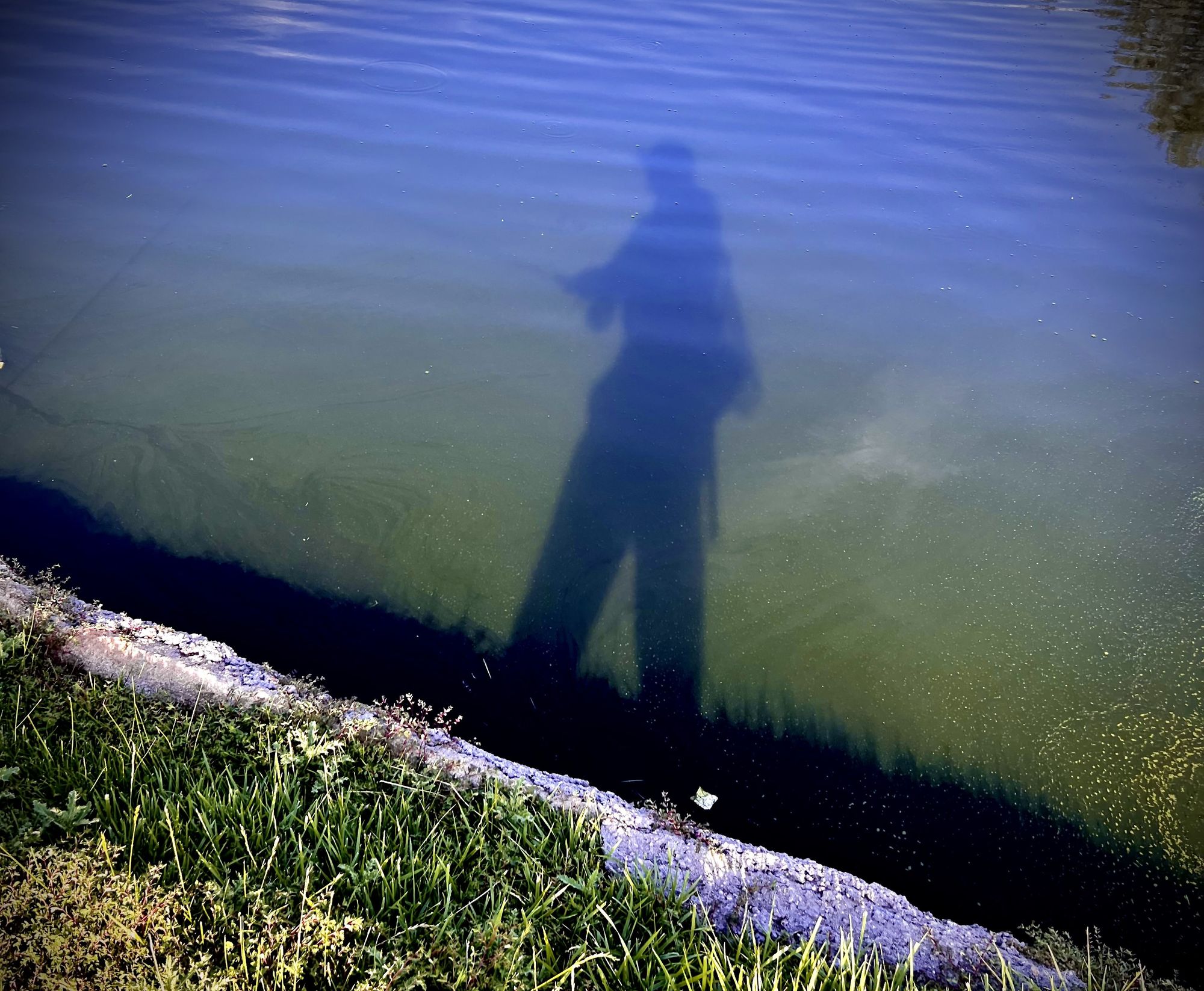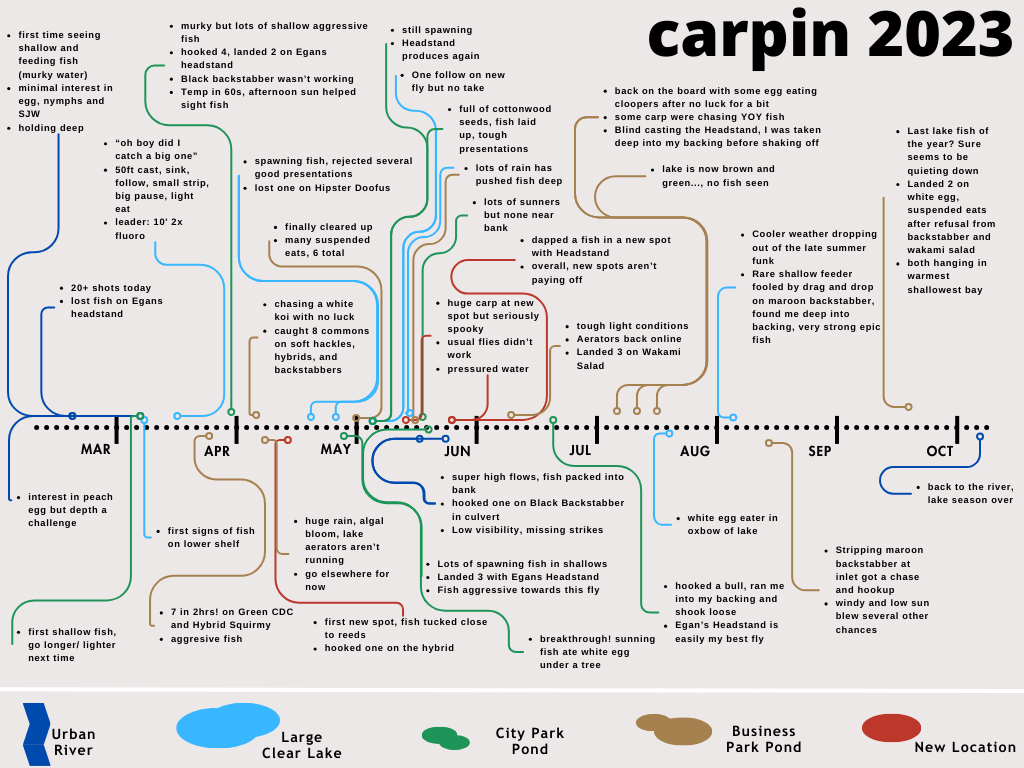Carper's Almanac: We Observed Carp Behavior for Two Years
We chased urban carp around for two year at a set of fixed locations, checking in regularly, and logged details to each encounter, what did we learn?

December 2023
I don't know if you've noticed, but around here there have been a few more carp articles popping up. Over the past two seasons we've worked hard on building up our expertise about carpin' on the fly. Not only to fill in our own personal gaps, but also to build out our library of resources for anglers who come to this site to learn.
As with learning anything new, starting is the hardest part. There are more questions than answers, and when it comes to carp, you'll eventually learn to live with that. Carp vary so widely in behavior, diet, habitat, that it's tough to generalize their patterns. But at the same time, there is a subset of carp, urban carp, that might be easier to learn from, where results can translate for carp anglers all over the place.
Due to human caused ecological homogenization, similar land-management practices have morphed most urban and suburban landscapes into essentially the same thing. The same concrete, the same grasses, the same ditches/canals, many of the same urban species too, including carp.
So, we chased urban carp around for two year at a set of fixed locations, checking in regularly, and logged details to each encounter, all in an effort to improve our understanding of how urban carp tick, and also to share our knowledge. We picked several types of carp habitat to observe, including an urban river system, a large clear lake, a small city pond fed by a ditch, a small business park pond fed by recycled water, and even occasional new locations as outside reference points. As a taste, here is a timeline from just last year...

With all the pieces in place, we set out to determine the best tactics for these various carp habitats, and to see if these different places fished similarly or not. Here are some answers to the questions we set out to address, and other observations we learned along the way.
Q: Most carp are found in ponds and lakes, when is the lake season for carp?
A: For the Colorado Front Range, things noticeable switch on by late April. Surprisingly each lake woke up at it's own pace, but things get better as April progresses but by the end of the month. This is when carp really move shallow to warm up, feed, and even prepare for spawning. Of course for other parts of the country (or world) the exact timing might vary, but one thing to note: April was the first month with minimum daily temperatures climbing above freezing (32F). After the initial excitement of spring, summer fishing settles in to consistent activity until September. As the season changes, chances seem harder to come by in October.

Q: When is the best month for chasing carp?
A: The first six weeks after fish show up in the shallows was consistently great. During this period, fish are most aggressive, hungry, and not as spooky. This was true across all the lakes we frequented, as well as the river. Plus, during our Spring seasons we usually have lots of clear bright days which helps with visibility. Even if fish are spawning, they circle in and out of the commotion, and become hungry and vulnerable on the fringes of spawning areas. But after spawning, with the arrival of peak summer heat, things settle in and each lake takes on unique traits.
Q: Do carp still stay active in the winter months?
A: Not in lakes, at least in the waters we observed. In rivers, absolutely. They don't venture shallow nearly as often, though we've still observed plenty of the pock-marks left behind from shallow feeding fish. They can still be hooked as well, but it takes extra attention to detail to get into position, make accurate casts, and present your flies deep enough. Plus they are spookier.

Q: Which are harder to fool, lake carp or river carp?
A: Big carp are harder to fool. It's tough to generalize lake vs river, but based on our experiences, the bigger they are-the smarter they are, and the less likely they are to be duped.
Q: How varied are tactics for different locations?
A: Sight fishing with the drag and drop approach was universally the best approach for catching carp regardless of setting. Opportunities for suspended flies and dry flies vary drastically, and generally didn't work very well. But if we drill down further, fly color and fly size varied based on water color/stain, and time of year.
Q: What color fly should I use in stained lakes?
A: Other sources suggest starting with black, always keep that one as an ace in the hole. But we've noticed that in green tinged lakes the Chartreuse headstand has done an excellent job. Many fish, especially early in the year, charged at this fly as soon as "the drop" (as in the drag and drop cast) was initiated. It however, hasn't worked as well in brown stained lakes. Black has done better in the brown stained water. Muted colors worked best in clearer water, especially olive. Maroon also worked well in both clear and stained situations.
Q: Do urban carp ever chase streamers or eat other fish? Can I blind cast for carp?
A: At one location, we don't think any other fish species are present besides carp. After spawning, by late summer, when young of the year carp are starting to get bigger, around an inch, we observed signs of carp crashing baitfish, eating these young fish. Most likely these carp are eating the small young fish as many food sources are limited by this time of year. These baitfish chasing carp can be hooked, though it requires blind casting and isn't that successful. But we hooked a couple this way, and man do they pull in these situations.
Q: Did you find any success approaching non-feeding fish that are sunning, or just cruising by?
A: These fish are usually considered tough to catch. It took lots of failed attempts to make progress. But we did make progress. Admittedly with a small sample size, we've noticed slowly cruising fish and laid up fish respond favorably to egg patterns. Specifically a white egg. This fly lands softly, sinks surprisingly quickly (if submerged and prepped beforehand) and we've even had fish circle back on poorly presented flies and still eat. The trick in those situations is to stay patient, and wait for the fish to fully eat the fly. It's possible that the white egg's success coincides with the explosion of cottonwood seeds in early summer, but we also had luck late in the year with the white egg when things get spookier.
Q: What were your best flies?
A: Black backstabber, Maroon backstabber, Chartreuse Headstand, White Egg, Green CDC Nymph, Carp Hybrid, Wakami Salad, Rusty Headstand, soft hackles, and the Headstand Damsel all had their place (below image: left to right).

Q: What flies didn't work like you thought they would?
A: Larger crayfish didn't get as much attention as smaller flies, which was slightly surprising. In several situations we tried slowly stripping unweighted damsel nymphs to intercept cruising fish, and sometimes we got a reaction, but never got an eat. Several times we attempted dry droppers, with hoppers and chironomids underneath with no success. Too often the splash of this rig landing on the water disrupted the fish we were targeting.
Q: Are carp anything other than a warmwater fish?
A: Some push back on defining carp as only a warmwater fish, but we disagree. Its true that carp will feed when its cold, and stay active throughout the winter. But when a carp rips line off of your reel and chases you into your backing, it's during the height of warmwater season, not in the dead of winter. Similarly, it's true that some trout (especially brown trout) can tolerate temperatures above 70F, but obviously that doesn't make them a warmwater fish...
Q: What other trends did you notice?
A-1: On smaller bodies of water, any influx of flows can really put the bite on. Many urban ponds are connected to ditches or other water supplies, and throughout the summer whenever a lake's surface height increases, it provides more substrate for carp to root around and find new morsels. This can be difficult to time, but when a small lake is low with lots of exposed shoreline it might be better to pass on that lake until levels rebound. Try to be there soon after that fresh water comes in, they'll be eating.
A-2: Pay attention to weather conditions, and light conditions especially. Some overcast days provided extremely challenging sight fishing, not impossible, but difficult for target acquisition and strike detection. Those conditions wouldn't stop me from going, but it's good to set realistic expectations when conditions are tough. Often, hook sets were more challenging to detect quickly.
A-3: 8wt rods seem like the right choice, but they lack the subtlety in presentation that is often required to drag and drop to a feeding carp. A 6wt rod has been plenty powerful to land fish past 20 lbs.
A-4: We had to do considerable scouting to find good fishing, even amongst these productive lakes. Sometimes we'd walk a lake/pond and not see any fish shallow, so we'd jump to another location. This was a better option for producing fish than waiting around at one location hoping that fish to show up.
Want to learn more about grass carp? Us too. If anyone wants to share grassie knowledge, we're looking for information for similar future projects, lets talk!



